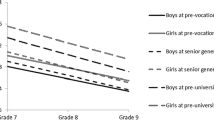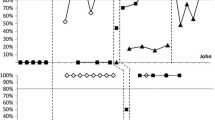Abstract
Behavior analysts have long been interested in developing and promoting the use of effective generalization strategies for behavioral interventions. Perhaps because research on academic performance has lagged behind in the field of applied behavior analysis, far less research on this topic has been conducted for academic performance problems. The purpose of this article is to comment on the six reports of experimental studies that make up this special issue. The methods investigated by the authors in this special issue are innovative and raise many intriguing questions that should fuel further research and development of strategies for improving generalized academic skills. The article concludes with thoughts about what we know as a field, and what has yet to be examined through future research.
Similar content being viewed by others
References
Alessi, G. (1987). Generative strategies and teaching for generalization. The Analysis of Verbal Behavior, 5, 15–27.
Ardoin, S. P., & Daly, E. J., III. (2007). Introduction to the special series: Close encounters of the instructional kind—how the instructional hierarchy is shaping instructional research 30 years later. Journal of Behavioral Education, 16, 1–6.
Billington, E. J., Skinner, C. H., & Cruchon, N. M. (2004). Improving sixth-grade student’s perceptions of high-effort assignments by assigning more work: Interaction of additive interspersal and assignment effort on assignment choice. Journal of School Psychology, 42, 477–490.
Binder, C. (1996). Behavioral fluency: Evolution of a new paradigm. The Behavior Analyst, 19, 163–197.
Carpenter, P. A., & Moser, J. M. (1982). The development of addition and subtraction problem solving skills. In T. P. Carpenter, J. M. Moser, & T. A. Romberg (Eds.), Addition and subtraction: A cognitive perspective (pp. 9–24). Hillsdale, NJ: Lawrence Erlbaum Associates.
Catania, A. C. (2007). Learning (interim edition). Cornwall-on-Hudson, NY: Sloan Publishing Co.
Daly, E. J., III., Bonfiglio, C. M., Mattson, T., Persampieri, M., & Foreman-Yates, K. (2005). Refining the experimental analysis of academic skill deficits, Part I: An investigation of variables affecting generalized oral reading performance. Journal of Applied Behavior Analysis, 38, 485–498.
Daly, E. J., III., Martens, B. K., Barnett, D., Witt, J. C., & Olson, S. C. (2007). Varying intervention delivery in response-to-intervention: Confronting and resolving challenges with measurement, instruction, and intensity. School Psychology Review, 36, 562–581.
Deno, S. L., & Mirkin, P. K. (1977). Data-based program modification: A manual. Reston, VA: Counsel for Exceptional Children.
Friman, P. C., & Poling, A. (1995). Making life easier with effort: Basic findings and applied research on response effort. Journal of Applied Behavior Analysis, 28, 583–590.
Haring, N. G., & Eaton, M. D. (1978). Systematic instructional procedures: An instructional hierarchy. In N. G. Haring, T. C. Lovitt, M. D. Eaton, & C. L. Hansen (Eds.), The fourth R: Research in the Classroom (pp. 23–40). Columbus OH: Merrill.
Harp, S., & Mayer, R. (1998). How seductive details do their damage: A theory of cognitive interest in science learning. Journal of Educational Psychology, 90, 414–434.
Heward, W. L. (1994). Three “low-tech” strategies for increasing the frequency of active student response during group instruction. In R. Gardner III, D. M. Sainato, J. O. Cooper, T. E. Heron, W. L. Heward, J. W. Eshleman, & T. A. Grossi (Eds.), Behavior analysis in education: Focus on measurably superior instruction (pp. 283–320). Pacific Grove, CA: Brooks/Cole Publishing Co.
Johnson, K. R., & Layng, T. V. J. (1992). Breaking the structuralist barrier: Literacy and numeracy with fluency. American Psychologist, 47, 1475–1490.
Martens, B. K., Eckert, T. L., Begeny, J. C., Lewandowski, L. J., DiGennaro, F. D., Montarello, S. A., et al. (2007). Effects of a fluency-building program on the reading performance of low-achieving second and third grade students. Journal of Behavioral Education, 16, 39–54.
McCurdy, M., Daly, E. J., III., Gortmaker, V., Bonfiglio, C. M., & Persampieri, M. (2007). Use of brief instructional trials to identify small group reading strategies: A two experiment study. Journal of Behavioral Education, 16, 7–26.
Miltenberger, R. G. (2008). Behavior modification: Principles and procedures (4th ed.). Belmont, CA: Wadsworth/Thomson Learning.
Poncy, B. C., Skinner, C. H., & O’Mara, T. (2006). Detect, practice, and repair: The effects of a class-wide intervention on elementary students’ math fact fluency. Journal of Evidence Based Practices for Schools, 7, 47–68.
Skinner, C. H. (1998). Preventing academic skills deficits. In T. S. Watson & F. Gresham (Eds.), Handbook of child behavior therapy: Ecological considerations in assessment, treatment, and evaluation (pp. 61–83). New York: Plenum.
Skinner, C. H., Fletcher, P. A., & Henington, C. (1996). Increasing learning rates by increasing student response rates: A summary of research. School Psychology Quarterly, 11, 313–325.
Skinner, C. H., Robinson, S. L., Morse, D. T., O’Neal, M. R., & Jackson, R. R. (1998). Effects of models’ reading rate on generalized reading performance in students with learning disabilities. International Journal of Special Education, 13, 54–64.
Stokes, T. F., & Baer, D. M. (1977). An implicit technology of generalization. Journal of Applied Behavior Analysis, 10, 349–367.
Author information
Authors and Affiliations
Corresponding authors
Rights and permissions
About this article
Cite this article
Skinner, C.H., Daly, E.J. Improving Generalization of Academic Skills: Commentary on the Special Issue. J Behav Educ 19, 106–115 (2010). https://doi.org/10.1007/s10864-010-9100-y
Published:
Issue Date:
DOI: https://doi.org/10.1007/s10864-010-9100-y




